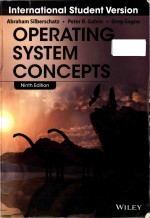图书介绍
Operating system concepts Ninth EditionPDF|Epub|txt|kindle电子书版本网盘下载

- Abraham Silberschatz; Peter B.Galvin; Greg Gagne 著
- 出版社: Wiley
- ISBN:9781118093757
- 出版时间:2014
- 标注页数:829页
- 文件大小:445MB
- 文件页数:847页
- 主题词:
PDF下载
下载说明
Operating system concepts Ninth EditionPDF格式电子书版下载
下载的文件为RAR压缩包。需要使用解压软件进行解压得到PDF格式图书。建议使用BT下载工具Free Download Manager进行下载,简称FDM(免费,没有广告,支持多平台)。本站资源全部打包为BT种子。所以需要使用专业的BT下载软件进行下载。如BitComet qBittorrent uTorrent等BT下载工具。迅雷目前由于本站不是热门资源。不推荐使用!后期资源热门了。安装了迅雷也可以迅雷进行下载!
(文件页数 要大于 标注页数,上中下等多册电子书除外)
注意:本站所有压缩包均有解压码: 点击下载压缩包解压工具
图书目录
PART ONE OVERVIEW4
Chapter 1 Introduction4
1.1 What Operating Systems Do4
1.2 Computer-System Organization7
1.3 Computer-System Architecture12
1.4 Operating-System Structure19
1.5 Operating-System Operations21
1.6 Process Management24
1.7 Memory Management25
1.8 Storage Management26
1.9 Protection and Security30
1.10 Kernel Data Structures31
1.11 Computing Environments35
1.12 Open-Source Operating Systems43
1.13 Summary47
Exercises49
Bibliographical Notes51
Chapter 2 System Structures53
2.1 Operating-System Services53
2.2 User and Operating-System Interface56
2.3 System Calls60
2.4 Types of System Calls64
2.5 System Programs72
2.6 Operating-System Design and Implementation73
2.7 Operating-System Structure76
2.8 Operating-System Debugging84
2.9 Operating-System Generation89
2.10 System Boot90
2.11 Summary91
Exercises92
Bibliographical Notes98
PART TWO PROCESS MANAGEMENT103
Chapter 3 Process Concept103
3.1 Process Concept103
3.2 Process Scheduling108
3.3 Operations on Processes113
3.4 Interprocess Communication120
3.5 Examples of IPC Systems128
3.6 Communication in Client-Server Systems134
3.7 Summary145
Exercises147
Bibliographical Notes158
Chapter 4 Multithreaded Programming161
4.1 Overview161
4.2 Multicore Programming164
4.3 Multithreading Models167
4.4 Thread Libraries169
4.5 Implicit Threading175
4.6 Threading Issues181
4.7 Operating-System Examples186
4.8 Summary189
Exercises189
Bibliographical Notes197
Chapter 5 Process Scheduling201
5.1 Basic Concepts201
5.2 Scheduling Criteria205
5.3 Scheduling Algorithms206
5.4 Thread Scheduling217
5.5 Multiple-Processor Scheduling218
5.6 Real-Time CPU Scheduling223
5.7 Operating-System Examples230
5.8 Algorithm Evaluation240
5.9 Summary244
Exercises245
Bibliographical Notes250
Chapter 6 Synchronization253
6.1 Background253
6.2 The Critical-Section Problem256
6.3 Peterson’s Solution257
6.4 Synchronization Hardware259
6.5 Mutex Locks262
6.6 Semaphores263
6.7 Classic Problems of Synchronization269
6.8 Monitors273
6.9 Synchronization Examples282
6.10 Alternative Approaches288
6.11 Summary292
Exercises292
Bibliographical Notes307
Chapter 7 Deadlocks311
7.1 System Model311
7.2 Deadlock Characterization313
7.3 Methods for Handling Deadlocks318
7.4 Deadlock Prevention319
7.5 Deadlock Avoidance323
7.6 Deadlock Detection329
7.7 Recovery from Deadlock333
7.8 Summary335
Exercises335
Bibliographical Notes340
PART THREE MEMORY MANAGEMENT345
Chapter 8 Memory-Management Strategies345
8.1 Background345
8.2 Swapping352
8.3 Contiguous Memory Allocation354
8.4 Segmentation358
8.5 Paging360
8.6 Structure of the Page Table372
8.7 Example:Intel 32 and 64-bit Architectures377
8.8 Example:ARM Architecture382
8.9 Summary383
Exercises384
Bibliographical Notes387
Chapter 9 Virtual-Memory Management389
9.1 Background389
9.2 Demand Paging393
9.3 Copy-on-Write400
9.4 Page Replacement401
9.5 Allocation of Frames413
9.6 Thrashing417
9.7 Memory-Mapped Files422
9.8 Allocating Kernel Memory428
9.9 Other Considerations431
9.10 Operating-System Examples437
9.11 Summary440
Exercises441
Bibliographical Notes450
PART FOUR STORAGE MANAGEMENT455
Chapter 10 File System455
10.1 File Concept455
10.2 Access Methods465
10.3 Directory and Disk Structure467
10.4 File-System Mounting478
10.5 File Sharing480
10.6 Protection485
10.7 Summary490
Exercises491
Bibliographical Notes492
Chapter 11 Implementing File-Systems495
11.1 File-System Structure495
11.2 File-System Implementation498
11.3 Directory Implementation504
11.4 Allocation Methods505
11.5 Free-Space Management513
11.6 Efficiency and Performance516
11.7 Recovery520
11.8 NFS523
11.9 Example:The WAFL File System529
11.10 Summary532
Exercises533
Bibliographical Notes536
Chapter 12 Mass-Storage Structure539
12.1 Overview of Mass-Storage Structure539
12.2 Disk Structure542
12.3 Disk Attachment543
12.4 Disk Scheduling544
12.5 Disk Management550
12.6 Swap-Space Management554
12.7 RAID Structure556
12.8 Stable-Storage Implementation566
12.9 Summary568
Exercises569
Bibliographical Notes572
Chapter 13 I/O Systems575
13.1 Overview575
13.2 I/O Hardware576
13.3 Application I/O Interface585
13.4 Kernel I/O Subsystem592
13.5 Transforming I/O Requests to Hardware Operations599
13.6 STREAMS601
13.7 Performance603
13.8 Summary606
Exercises607
Bibliographical Notes608
PART FIVE PROTECTION AND SECURITY611
Chapter 14 System Protection611
14.1 Goals of Protection611
14.2 Principles of Protection612
14.3 Domain of Protection613
14.4 Access Matrix618
14.5 Implementation of the Access Matrix622
14.6 Access Control625
14.7 Revocation of Access Rights626
14.8 Capability-Based Systems627
14.9 Language-Based Protection630
14.10 Summary635
Exercises636
Bibliographical Notes637
Chapter 15 System Security641
15.1 The Security Problem641
15.2 Program Threats645
15.3 System and Network Threats653
15.4 Cryptography as a Security Tool658
15.5 User Authentication669
15.6 Implementing Security Defenses673
15.7 Firewalling to Protect Systems and Networks680
15.8 Computer-Security Classifications682
15.9 An Example:Windows 7683
15.10 Summary685
Exercises686
Bibliographical Notes688
PART SIX CASE STUDIES695
Chapter 16 The Linux System695
16.1 Linux History695
16.2 Design Principles700
16.3 Kernel Modules703
16.4 Process Management706
16.5 Scheduling709
16.6 Memory Management714
16.7 File Systems723
16.8 Input and Output729
16.9 Interprocess Communication732
16.10 Network Structure733
16.11 Security735
16.12 Summary738
Exercises738
Bibliographical Notes740
Chapter 17 Windows 7741
17.1 History741
17.2 Design Principles743
17.3 System Components750
17.4 Terminal Services and Fast User Switching774
17.5 File System775
17.6 Networking781
17.7 Programmer Interface786
17.8 Summary795
Exercises795
Bibliographical Notes796
Chapter 18 Influential Operating Systems799
18.1 Feature Migration799
18.2 Early Systems800
18.3 Atlas807
18.4 XDS-940808
18.5 THE809
18.6 RC 4000809
18.7 CTSS810
18.8 MULTICS811
18.9 IBM OS/360811
18.10 TOPS-20813
18.11 CP/M and MS/DOS813
18.12 Macintosh Operating System and Windows814
18.13 Mach814
18.14 Other Systems816
Exercises816
Bibliographical Notes816